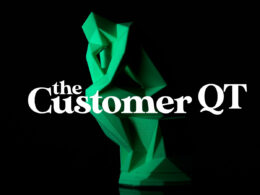Historically, having the best product or service on the market was the key to receiving and maintaining undying loyalty from consumers. Today, this strategy won’t cut it. The proliferation of the Internet has created a global economy where consumer choices are abundant. It no longer makes sense for consumers to maintain loyalty to brands. Instead, many base purchasing decisions on factors such as price and convenience; however, customer engagement is quickly emerging as the leading factor.
By Judd Marcello
Rather than only rely on customer loyalty programs like reward cards and frequent flyer miles, brands need to go one step further by developing emotional loyalty. This type of loyalty achieves a deep connection with customers that makes them feel valued and respected at every action, input and communication with a brand.
The 3 Components Of Emotional Loyalty
1. Affinity: “I like you…but I don’t love you.”
Customers have an affinity for a brand when they enjoy what the company offers: high-quality goods, branding that appeals to their style, or products at a great value. But liking a brand doesn’t mean being loyal to it. When a different option comes along, or customers find a more competitive price, those who merely like a brand may be swayed to spend their dollars elsewhere. In this case, the brand may not be doing its best to build a relationship with the customer.To gain a customer’s affinity, brands must deliver a high-quality product or service that provides value and elicits an emotional response. Brands can achieve affinity by:
- Managing offers at an individual level to help reinforce your brand’s value with customers.
- Communicating useful advice to ensure the usage of your product and reinforce quality/value.
- Adding bi-direction and engagement to email communications through surveys and polls to gauge the emotional response.
- Fostering relationships by inviting customers to share stories of affinity with their personal networks via social media.
2. Attachment: “You know me well.”
Attachment is less about liking a brand and more about making a connection. Customers will be able to tell if they are valued and appreciated by the relevance of the company’s communications and efforts to engage. When a brand makes an effort to connect in meaningful and personalized ways, customers feel valued, appreciated and confident in the company’s ability to meet their expectations.
To create an attachment between your customers and your brand, provide relevant communications, two-way interaction, added benefits as engagement increases and valuable content in multiple mediums. Three ways brands can foster attachment include:
- Rewarding interaction, as well as transactions.
- Recognizing customers with tiers that offer exclusive benefits and acknowledge their status in every communication.
- Engaging across devices, channels and touch points in a consistent, relevant, and integrated way.
3. Trust: “Let’s be friends.”
Trust is the linchpin of emotional loyalty — the must-have ingredient to retaining a loyal customer. When a customer feels respected, their willingness to trust increases. Communication is one of the most meaningful ways to show customers respect. Is their privacy prioritized? Is communication two-way so they can provide feedback? Customers are willing to put their trust in a brand, but only if every touch point, interaction and channel displays the same authentic behavior. And, sadly, one wrong move can result in loss of trust.
To create a sense of trust, offer authenticity, timely communications, a healthy respect for privacy and the ability to provide feedback. Strategies to gain customer trust include:
- Collecting first- and zero-party data in exchange for rewards and using this information to improve the customer experience while respecting privacy.
- Collecting first-party data to give customers a feedback loop and use the information gathered to personalize responses.
- Remaining true to the boundaries set forth by the customer (e.g., in the preference center).
Emotional Loyalty Drives Business Growth
Brands can and should use emotional connection as a growth strategy. Companies that successfully leverage emotional connection deliver extraordinary results, as measured in customer retention, lifetime value, cross-sales, brand advocacy and length of time spent with a brand.
To create emotional loyalty, your brand must offer a value exchange with customers and nurture the relationship at every touch point with unique, personalized brand experiences, content and offers. By employing these strategies, you’ll be able to deliver unique customer experiences that create deep emotional connections and ultimately achieve advanced-level loyalty that drives company growth.
 As the EVP of Global Marketing at Cheetah Digital, Judd Marcello oversees a global team that is responsible for all aspects of the brand, demand generation, digital marketing, corporate communications, and sales development.
As the EVP of Global Marketing at Cheetah Digital, Judd Marcello oversees a global team that is responsible for all aspects of the brand, demand generation, digital marketing, corporate communications, and sales development.
This article first appeared in RetailTouchPoints. Photo by Egor Lyfar on Unsplash.













1 comment